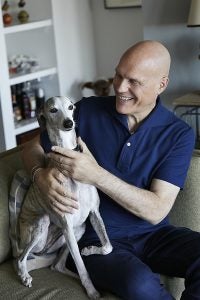In October, Tom Sietsema (SFS’83) stepped down as The Washington Post’s food critic after 26 years.
During his tenure, Sietsema wrote 1,200 restaurant reviews and 50 dining guides. He used pseudonyms and disguises while eating out 10 or so times a week.
Along the way, he covered America’s top food cities and the eating habits of Hillary Clinton, Donald Trump and Bernie Sanders; went undercover in the CIA’s dining room and in a kitchen as a dishwasher, and this fall, penned his final list of DC’s 40 best restaurants.
Sietsema’s journalism career dates back to his undergraduate years in Georgetown’s School of Foreign Service.
The Minnesota native set out to be a diplomat, but after internships at Good Morning America and the Chicago Sun-Times, he fell in love with reporting.
Decades later though, Sietsema still practices diplomacy — just not in the way he thought.
“I’ve been able to use diplomatic skills at the table for 26 years, so in a way, thank you Georgetown School of Foreign Service,” he said.
Find out how Sietsema carved his own path in food writing and how he practices diplomacy at the dinner table.
Culture Shock at Georgetown
Sietsema fell in love with Washington, DC, while spending a semester studying and interning there as an undergraduate. He was a student at Hamline University in St. Paul, Minnesota, at the time, and by the end of his exchange program, he didn’t want to leave DC.
Sietsema decided to apply to Georgetown and arrived on the Hilltop in 1981 — a “huge culture shock,” he said.
“I felt as if I were a representative of a class of people who were from the Midwest. I went to public schools. I was a Protestant. What amused me was how similar students were from around the world in their regard for Georgetown and Catholicism and making the world a better place.”
Sietsema lived in Village A, a few floors away from Patrick Ewing (C’85). He took German classes and a course taught by Jan Karski, a Polish WWII spy and diplomat and SFS professor. He ate mainly from the salad bar on campus, and in his off-hours, worked as a waiter at a pizzeria to save up money to eat out.
“What I loved about Georgetown was it seemed to be a magical place at the time,” he said. “I remember it being a really optimistic time in my life.”
Finding His Footing in Journalism
His senior year, Sietsema took the university’s first journalism class, taught by Ted Gup, then an investigative reporter at The Washington Post who worked under reporter Bob Woodward.
His classmates were Kara Swisher (SFS’84) — a “whirling dervish then and remains one now” — and Mary Jordan (C’83), a Pulitzer-Prize winning writer and editor for the Post, with whom he’d compare notes and help edit one another’s papers. The class taught the nuts and bolts of breaking into the news business, he said.
“I loved the Georgetown way of thinking and teaching, and I think I’m a better reporter because of the professors I had there,” he said.
Gup connected Sietsema with the Post, and after starting as a copy aide, he worked for Phyllis Richman, the newspaper’s restaurant critic. Sietsema tested recipes for readers, learning how to clean squid, prepare African peanut stew and bake colonial cakes — among the more than a thousand dishes he finessed for readers.
“It was the greatest cooking class,” he said. “I think my grocery bill was double my rent.”
After cutting his teeth in food writing, Sietsema headed west, working as a food editor, reporter and/or critic for the Milwaukee Journal Sentinel, the San Francisco Chronicle and the Seattle Post-Intelligencer, before a role covering restaurants for Microsoft’s Sidewalk brought him back to DC.
In 2000, Sietsema took on the mantle of the Post’s chief food critic.
Food as Diplomacy
In covering restaurants for 26 years, Sietsema has been able to put his diplomacy skills to good use.
He says he tries to make his dining companions feel comfortable, encourages them to try a new food or shows them how to eat a certain dish. In the process, Sietsema has found that people often open up.

“I would take a starving artist or a young family to a big deal restaurant just to see it through their eyes,” he said. “I like to take hoity-toity people to dives. I realized people would open up over a meal in a way they never would in a different setting. I’ve had people tell amazing stories over the years. I feel it’s been a masterclass in life and living.
“Food is a diplomatic tool. It can be symbolic. It’s nourishment. It’s been the most important thing in my life really.”
After logging thousands of reviews, Sietsema is looking forward to becoming a regular in restaurants. He also plans to cook more. He’s hosting a monthly lamb burger night for DC movers and shakers. He recently invited his Uber driver, an Afghan contract worker, to join, he said.
“He’s going to be the most important guest there,” he said. “You can effect change one meal at a time, and that’s what I want to do. I’m very optimistic about the future.”
Pro Tip
Where to eat out in Georgetown: Chez Billy Sud, My Little Chamomile, the River Club and Le Bonne Vache.
Editor’s Note: The first photo in the story is by Marvin Joseph/The Washington Post.

